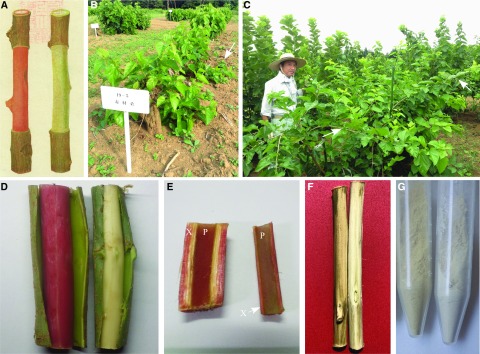Figure 1.
Morphological characteristics of cv Sekizaisou. A, A hand-made painting of debarked branching stems of cv Sekizaisou (left) and a control mulberry (right) published by Hotta (1950). B and C, cv Sekizaisou plantlets growing in the experimental field in early summer and midsummer, respectively. The creeping growth habit can be observed for the branches originating from the bottom part of the stumps (white arrows in B). Unlike other cultivars growing upright, such as the plants growing behind cv Sekizaisou, most of the branches of cv Sekizaisou drooped (white arrows in C), and supporting poles were necessary to maintain upward growth of the main stems. D, Debarked branches of cv Sekizaisou (left) and cv Nezumigaeshi (right) prepared from plants in midsummer. E, Longitudinal sections of top (right) and bottom (left) parts of branches of cv Sekizaisou. The red color of the inner xylem, close to the pith parenchyma, was lighter than that of the outer xylem. X and P indicate xylem and parenchyma tissues, respectively. F, Debarked stems of cv Sekizaisou (left) and cv Nezumigaeshi (right) after air-drying for 3 d. The xylem tissue of cv Sekizaisou turned brown. G, Wood powder of extractive-free wood from cv Sekizaisou (left) and cv Nezumigaeshi (right). The resultant brown pigment in air-dried xylem could not be removed from the powder upon sequential extraction with hot water and organic solvents.

